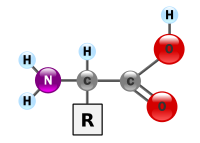
Photo from wikipedia
The muscle protein synthetic response to the ingestion of animal based proteins has been reported to be superior to the ingestion of plant based proteins. The lesser anabolic properties of… Click to show full abstract
The muscle protein synthetic response to the ingestion of animal based proteins has been reported to be superior to the ingestion of plant based proteins. The lesser anabolic properties of plant based compared with animal based proteins has been attributed to differences in essential amino acid (EAA) contents and amino acid composition. This study compares post-prandial muscle protein synthesis rates following the ingestion of 30 g milk protein with the ingestion of 30 g corn protein or a blend of 30 g corn and milk protein in vivo, in young males. In a randomized, double blind, parallel-group design, 36 healthy young males (26 ± 4 y) received a primed continuous infusion of L-[ring-13C6]-phenylalanine and ingested 30 g milk protein (MILK), 30 g corn protein (CORN), or a blend of 15 g corn protein plus 15 g milk protein (CORN + MILK) (n = 12 per group). Blood and muscle biopsies were collected for 5 h following protein ingestion to assess post-prandial plasma amino acid profiles and myofibrillar protein synthesis rates. Data were analyzed with 2-way repeated measures ANOVA and independent samples t-test. Data are expressed as mean ± SD. MILK increased plasma EAA concentrations more when compared to CORN (incremental area under curve (iAUC): 151 ± 31 vs 77 ± 19 mmol/L/300 min, respectively; P < 0.001). Both milk and corn protein ingestion increased myofibrillar protein synthesis rates (P < 0.001), with no differences between MILK and CORN (from 0.014 ± 0.014 to 0.053 ± 0.013 and from 0.017 ± 0.011 to 0.052 ± 0.013%/h, respectively; time*treatment P = 0.661). When MILK was compared to CORN + MILK, the iAUC for plasma EAA concentrations increased more in MILK when compared to CORN + MILK (151 ± 31 vs 126 ± 24 mmol/L/300 min, respectively; P = 0.036). Corn plus milk protein ingestion also increased myofibrillar protein synthesis rates (from 0.015 ± 0.015 to 0.052 ± 0.024%/h; P < 0.001), with no differences between MILK and CORN + MILK (time*treatment P = 0.823). Ingestion of 30 g milk protein, 30 g corn protein, or a blend of 15 g corn plus 15 g milk protein increases muscle protein synthesis rates in vivo in young males. Post-prandial muscle protein synthesis rates following the ingestion of 30 g milk protein do not differ from rates observed after ingesting 30 g corn protein or a blend providing 15 g milk plus 15 g corn protein in vivo, in young males. TiFN.
Journal Title: Current Developments in Nutrition
Year Published: 2020
Link to full text (if available)
Share on Social Media: Sign Up to like & get
recommendations!